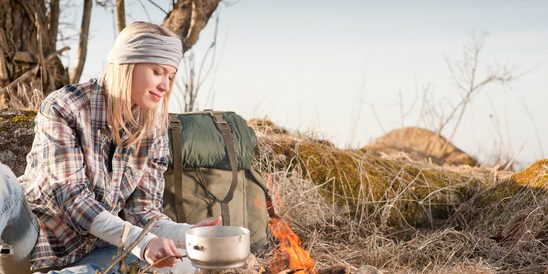When you’re out in the backcountry putting in full days of activity, you want food that will nourish you, strengthen you, revitalize you and taste really good. This article will help you plan your backpacking meals and snacks.
How Much Food Should You Pack?
When pondering how much or little to carry, err on the side of taking a little more. One of the Ten Essentials for an overnight trip, in fact, is a supply of extra food. A reasonable goal is 1.5 to 2.5 lbs. of food (or 2,500 to 4,500 calories) per person per day depending on your size, weight and exertion level.
On the other hand, don’t overdo it. A common blunder is to pack too much food, forcing you to lug unwanted bulk and weight. Experience will teach you what amount of food works for you
Meal Planning Considerations
Taste: Eat what you like. Don’t try to convert your taste buds to new types of food deep in the backcountry.
Calories: Don’t inaugurate a diet program during a multiday hike. You’ll need ample calories (and water) to fight off fatigue and headaches.
Nutrition: It’s fine to tear into a candy bar during a trip, but for the long haul you want to rely on complex carbohydrates and proteins. Intelligent quick snacks such as nuts and dried fruits provide more stable energy for your muscles than that candy bar.
Weight and bulk: Stick to lightweight and low-bulk backpacking food as much as possible, especially on long journeys. Consider repackaging foods into resealable plastic baggies to minimize bulk and garbage. Be sure to clearly label the baggies and include cooking instructions.
Ease of preparation: Unless you are an experienced camp chef, keep things simple. Always include no-cook food items in case your stove malfunctions.
Availability of water: This can vary greatly depending on where you’re going and can influence what backpacking food you choose to bring.
Fuel: Check the cook time for foods such as pasta, potatoes, rice, quinoa, etc. and make sure to plan for enough fuel (some of these dishes take a deceptively long time to cook).
Cost: Convenience has its price. Freeze-dried meals and energy foods can be expensive, but at the end of a long day when your weary body only has enough energy to boil water, such luxuries are justifiable.
Meal Options
Fresh foods: Refrigeration is one of those luxuries you leave behind at the trailhead. Most fresh foods are good for one day inside your pack, maybe two. Carrots usually last longer.
Dry foods (pasta, noodles, instant rice, soup mixes, drink mixes) are light, take up minimal volume inside a pack and offer you some decent taste alternatives.
Freeze-dried/dehydrated foods are super convenient. While relatively pricey, they deliver above-average taste and sustenance for very little weight.
Canned foods have a place in your pack only if the trip is short and your hunger for familiar food is high (some typically canned foods also come in vacuum-sealed pouches). Tuna or other canned meat products can be a nice toss-in item for a pot of rice, for instance. But skip foods packaged in traditional 15-ounce (or larger) cans or bottles. The weight and bulk just aren’t worth it.
Spices can boost the appeal of backpacking food. Consider bringing pepper, garlic powder or salt, basil, cayenne pepper, lemon pepper, cumin, crushed red pepper, cinnamon or whatever else is essential to your home kitchen.
Flavored beverages can taste mighty refreshing after a few days of nothing but water. Powdered drink mixes offer a nice mid-trip treat.
For winter camping, bring extra food to help keep your internal fires stoked. Carry your ready-to-eat items close to your body during the day so they are not frozen solid when you want to eat them.
Backpacking Meal Ideas
Breakfast
Backpacking breakfasts can range from fast and basic (an energy bar) to a lavish spread involving pancakes, eggs, meats and coffee. A hot meal can give you an extra boost, true, but a light snack means no cleanup and a quicker start to the day.
Popular choices: Instant hot cereals, dehydrated eggs, pancake mix, breakfast bars, granola, dry cereal, instant tea, coffee, powdered milk, juice, fresh fruit, dried fruits.
Lunch
Rather than take a prolonged break for a midday meal (involving unpacking, preparation, cleanup and repacking), a quicker strategy is to graze on a series of modest energy-boosting snacks throughout the day.
Popular choices: Jerky, dried fruit, fig bars, bagels (best for shorter trips), energy bars and nuts.
Dinner
This is your reward for a day of exertion. Backcountry gourmets don’t mind the extra challenge of creating hearty meals out in the great scenery. Most weary backpackers, though, opt for the just-add-boiling-water convenience of prepackaged freeze-dried or dehydrated meals, or simple dishes such as pasta.
Popular choices: Packaged meals, pasta, instant rice, ramen noodles, instant soups and sauces, instant stuffing, instant potatoes and tuna. Consider bringing along some favorite spices (onion and garlic powder, basil, oregano).
Source: http://www.rei.com/learn/expert-advice/planning-menu.html






